1867, Baby! An introduction to just one year in the Shield 5c series.
The 1867 with-rays subtype accounts for less than 7% of the five-cent pieces struck that year (with the no-rays subtype accounting for 93% or so of the mintage that year). Most type collectors opt for the 1866 as an example of the with-rays subtype. But, although the 1866 is less expensive than the 1867 with rays, perhaps the difference in price should be even greater given the relative surviving populations. That is, the 1867 with rays might be a better "value" even though it is more expensive than the 1866.
Most collectors are familiar with the difficulties that the Mint experienced in striking Shield Nickels, and that the rays were removed to improve striking characteristics and to prolong die life, which was a woefully low 15,000-20.000 strikes per die. Consequently, it's difficult to find an attractive 1867 5c with rays, one with good luster, some eye appeal, and an acceptable strike. I'll start out by posting a non-variety 1867 with rays and save a couple of the varieties for later.
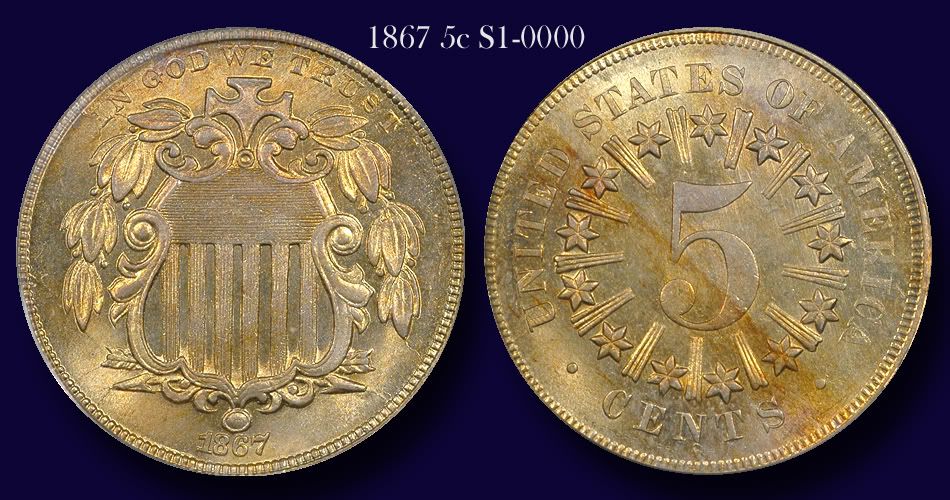
Here's a wicked nice RPD with the underlying digits far west.
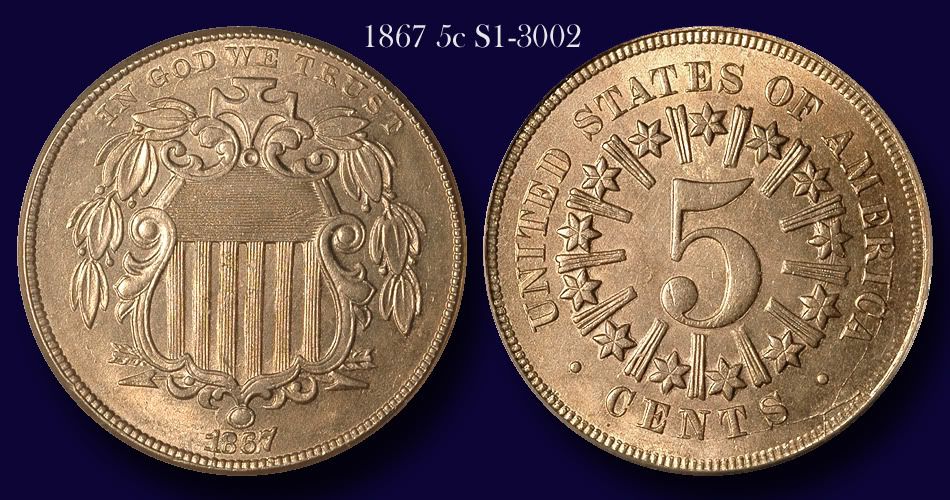
One of my weaknesses are "two-fers" in the Shield 5c series. "Two-fers" are coins that bear two different die characteristics that would each qualify the coin as a die variety independent of the other. Coins that were struck with a doubled die that bears a repunched date are "two-fers." Remember that a die is doubled as a result of multiple, offset pressings from the hub. All the working dies in the Shield 5c series were date punched by hand after they were hubbed. So, a doubled date -- what we refer to as a repunched date -- should not be mistaken for a doubled die. The die doubling and the repunched date on a "two-fer" are necessarily the result of two different events at separate stages of the die production process.
Here are two examples of two-fers from 1867, one with the with-rays reverse, and one without rays. Each example has a nice spread in both the doubling and the repunching. I need to take close-up shots to show the varieties more clearly. Maybe I'll take the pictures and add them later. You'll see the doubling most clearly at the annulet (the circle below the cross) and the cross itself.
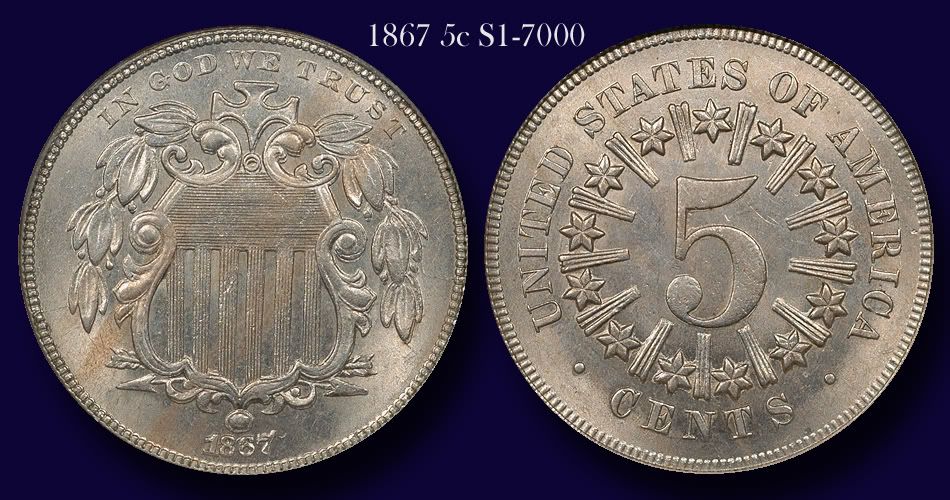
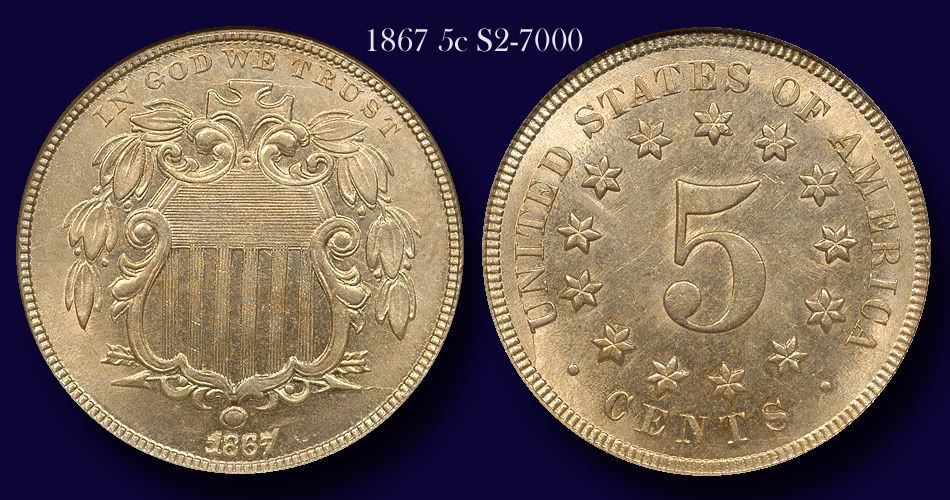
Howard Spindel (howards, here on the boards) wrote an article a while ago in Numismatist on a special variety of 1867 no-rays proofs. (I can't remember the date of the issue, and I don't have it with me.) Howard's piece expounded initial research and findings by John Dannreuther and Sunnywood (his handle on the PCGS Boards). The 1867 proof pictured below was struck with the prototype reverse die used on transitional pattern J-507 (also used on J-573). Bob Julian's research shows that the mint produced 25 five-cent proofs delivered in early February 1867, and it has long been thought that the notation referred to coins struck with the with-rays reverse (which accounts for the astronomical prices of the '67 w/ rays proofs). It's pretty clear now that the Mint record refers to no-rays proofs struck with the prototype reverse. The market has a long way to go before it catches up to the updated research.
Here's an example of the 1867 5c proof with prototype reverse (along with the J-507). I've also included an 1867 no-rays regular issue (minor repunched date) so that you can compare the reverses and see the difference in the relative positions of the stars and letters, as well as the different style 5 . . . I don't have a common '67 no-rays proof to post for comparison.
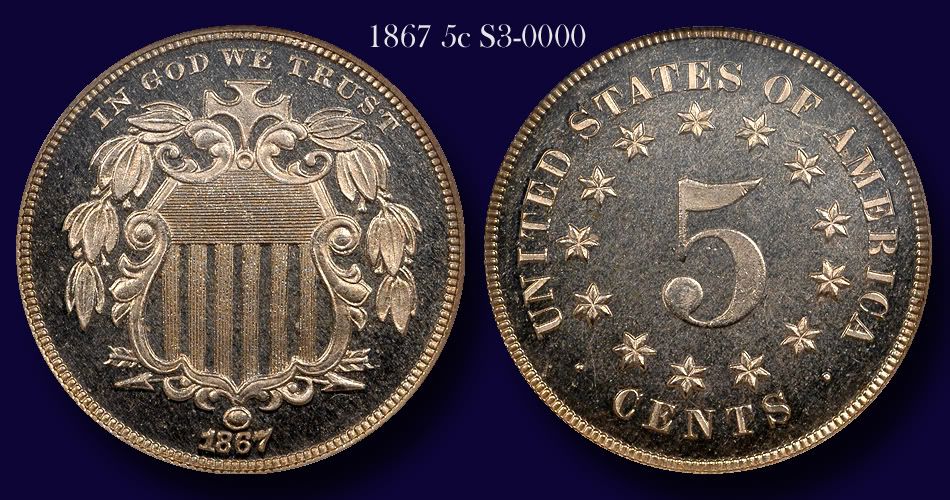
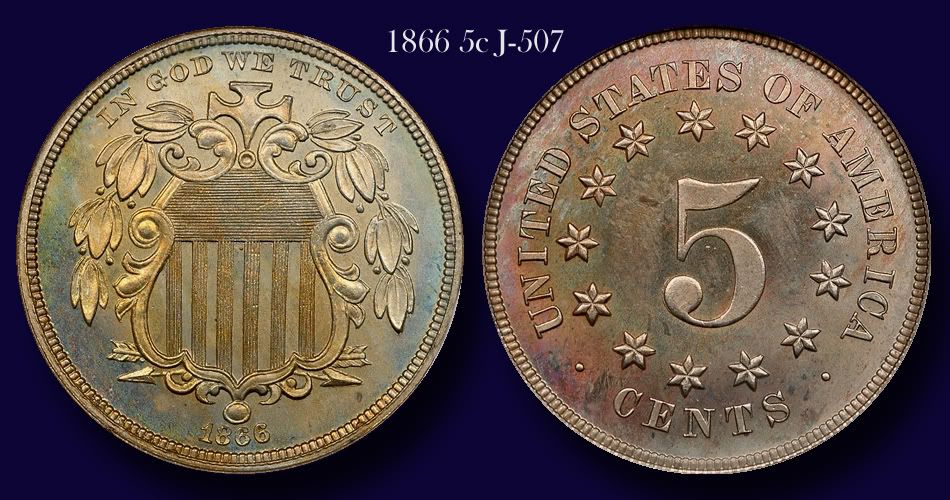
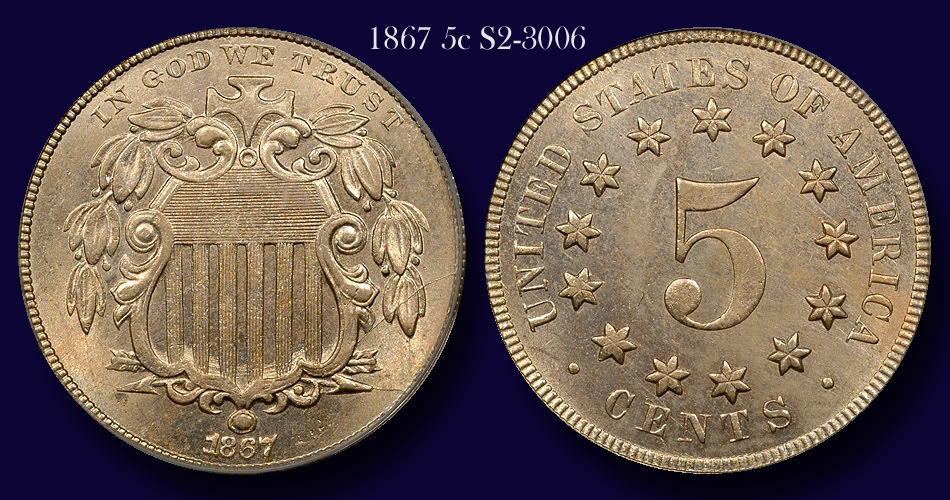
The year 1867 is packed full of interesting things for nickel afficionados to learn, to ponder, and to collect. When Congress enacted the legislation authorizing the production of the Cu/Ni 5c piece beginning in 1866, it was intended in large part to redeem the fractional currency that was issued during the Civil War. Both Congress and the Mint originally thought that use of a base metal for subsidiary coinage was a temporary measure, and many regarded base-metal coinage as mere "tokens" due to the composition of the coins. Longacre, the Chief Engraver of the Mint who designed the Shield 5c, favored return to use of metal with intrinsic value.
In 1867, Longacre advocated the use of aluminum for the 5c series (which was a metal with high intrinsic value at the time), and he prepared a pattern piece to help make his argument. He describes the piece and its purpose in correspondence to Secretary McCulloch through Director Linderman:
" . . . . I know not how far it may coincide with the present or future policy of the Government -- but it has appeared to me as a desideratum, that the portion of the circulating medium -- designated as fractional currency should possess an instrinsic value in the material of which it is composed, which it has not now.
If this view should be entertained now, or hereafter: it is important to find or suggest a material that would meet the exigency. The use of aluminum for the purposes of coinage, was suggested by its peculiar qualities as I became acquainted with them: especially when I ascertained that it was employed successfully in Paris for the purpose of striking medals.
. . . . These considerations have induced me to prepare for the purpose from dies designed and engraved by myself -- the accompanying specimens, corresponding in size with the coin above mentioned [the Half Eagle], in order to exhibit fully and fairly under the usual process of coining, the fitness of the metal for the requisite operations. . . ."
Letter from J. Longacre to H. McCulloch (June 12, 1867), quoted in D. Taxay, The U.S. Mint and Coinage at 245-46 (1966) (emphasis added). Of course, the nickel advocates had their way, and the Mint continued production of the Shield 5c in copper-nickel alloy (75:25) through 1883. In fact, the composition of the nickel hasn't changed (aside from the War Nickels of 1942-45) to the present date, 142 years later. Longacre might be pleased to know that the intrinsic value of the five-cent piece -- at long last -- actually exceeds its face value.
The aluminum piece that comes from "dies designed and engraved by [Longacre] [him]self," J-561, is not rare as far as patterns go, but it is far and away my favorite pattern for many reasons, including the elegance of the design indisputably created by Longacre's own hand and its place in numismatic history.

Longacre also prepared at least two hub trials (each is unique) for the design. The hub trial takes us one step closer to Longacre than the J-561 takes us. It's hard to tell from the photo, but the design elements are incuse as well as reversed (like you would expect to see on a die). This piece is a "snapshot" of one stage in Longacre's creative process for the 561. You'll see on the hub trial, for example, that the word UNION is not yet punched into the headdress, a significant addition reminding us that the Civil War had just ended. You'll also note that Longacre modified the design slightly by repunching the stars before striking the 561, and you can see scribe lines (circular, horizontal, and vertical) used to position the letters.

Here are a couple of fun nickels from 1867. The first is an 1867, and the second might be an 1867, but it's more likely an 1866. But I'll post it here in hopes that I'll eventually confirm that it's a '67 with rays. If anyone has a Shield 5c from '66 or '67 with die markers that match the reverse of the coin in the second photo, please let me know!
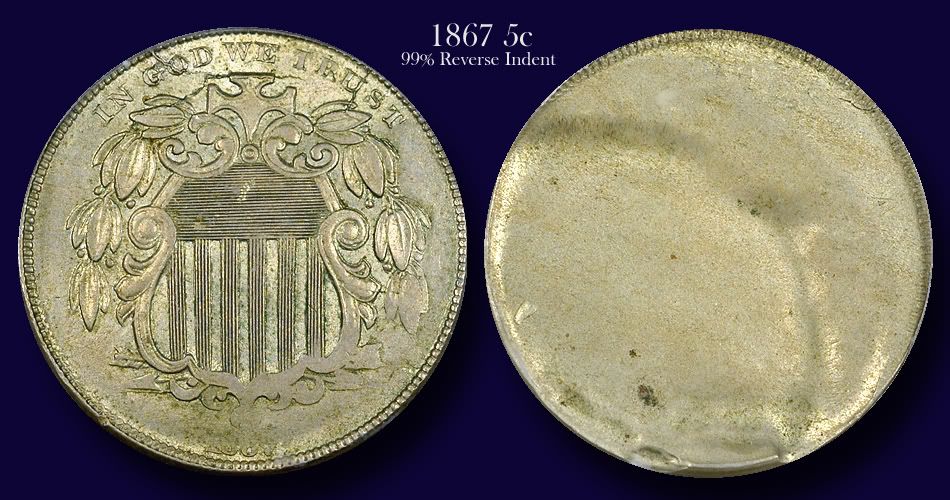
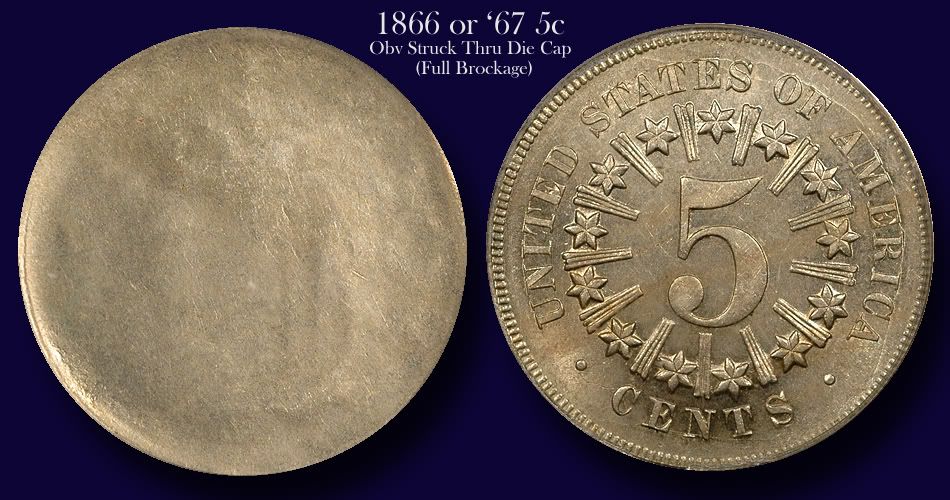
And here's another error from 1867 . . . a with rays struck on a thin planchet. You can read a bit more about this coin in another thread here. Just how thin the coin is can be easily seen when compared with the thickness of a regular Shield in the second picture.
I forgot to update this thread with a letter that RWB found in the archives. Taxay refers generally to the 5c patterns of 1867: "When, in 1867, Longacre removed the rays from among the stars, many persons thought that one or the other of the two varieties was counterfeit. Rumors grew so persistent that the Mint considered abandoning the shield and starry circle altogether, and a number of new models were prepared." D. Taxay, The U.S. Mint and Coinage at 245 (1966 & 1983 ARCO Pub. ed.). Taxay, however, did not provide any citation to the record. RWB's find of the handwritten letter from Linderman to McCulloch constitutes evidence to support Taxay's statement, and it clearly refers to the design of J-A1867-15. These events preceded the uniform minor coinage proposal of 1868, and the letter was written at nearly the same time that Longacre wrote his letter advocating for J-561. So, clearly, the hub trials for these two designs of 1867 belong together.
Here's a photo of both the letter with a transcription of the letter for ease of reading (a picture of J-A1867-15 appears in a subsequent post):
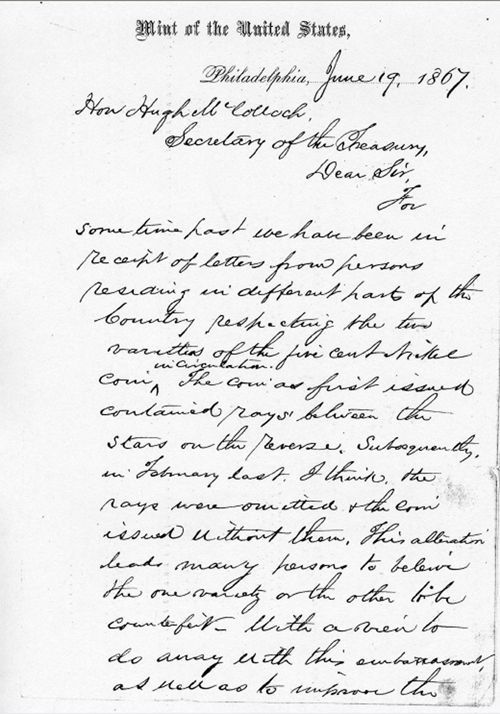
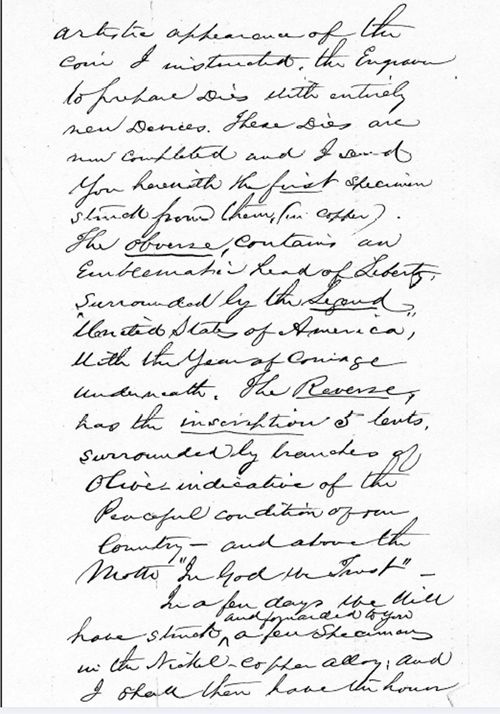
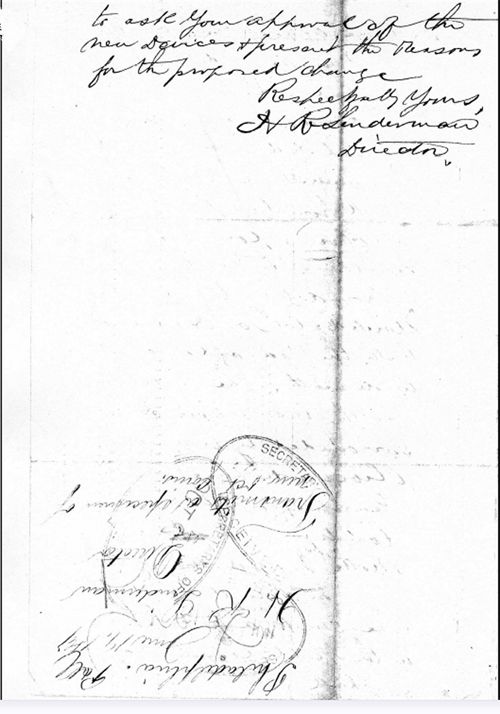
Mint of the United States
Philadelphia, June 19, 1867
Hon Hugh McColloch,
Secretary of the Treasury,
Dear Sir,
For some time past we have been in receipt of letters from persons residing in different parts of the Country respecting the two varieties of the five cent Nickel coin in circulation. The coin as first issued contained rays between the stars on the reverse. Subsequently, in February last, I think, the rays were omitted + the coin issued without them. This alteration leads many persons to beleive [sic] the one variety or the other to be counterfeit. With a view to do away with this embarrassment, as well as to improve the artistic appearance of the coin I instructed the Engraver to prepare Dies with entirely new Devices. These Dies are now completed and I send You herewith the first specimen struck from them (in copper). The obverse contains an Emblematic head of Liberty, surrounded by the Legend “United States of America” with the year of coinage underneath. The Reverse has the inscription 5 Cents, surrounded by branches of Olives indicative of the Peaceful condition of our Country – and above the Motto “In God we Trust.”
In a few days we will have struck and forwarded to you a few Specimens in the Nickel-copper alloy; and I shall then have the honor to ask your approval of the new Devices + present the reasons for the proposed change.
Respectfully yours,
H. R. Linderman
Director
Most collectors are familiar with the difficulties that the Mint experienced in striking Shield Nickels, and that the rays were removed to improve striking characteristics and to prolong die life, which was a woefully low 15,000-20.000 strikes per die. Consequently, it's difficult to find an attractive 1867 5c with rays, one with good luster, some eye appeal, and an acceptable strike. I'll start out by posting a non-variety 1867 with rays and save a couple of the varieties for later.

Here's a wicked nice RPD with the underlying digits far west.

One of my weaknesses are "two-fers" in the Shield 5c series. "Two-fers" are coins that bear two different die characteristics that would each qualify the coin as a die variety independent of the other. Coins that were struck with a doubled die that bears a repunched date are "two-fers." Remember that a die is doubled as a result of multiple, offset pressings from the hub. All the working dies in the Shield 5c series were date punched by hand after they were hubbed. So, a doubled date -- what we refer to as a repunched date -- should not be mistaken for a doubled die. The die doubling and the repunched date on a "two-fer" are necessarily the result of two different events at separate stages of the die production process.
Here are two examples of two-fers from 1867, one with the with-rays reverse, and one without rays. Each example has a nice spread in both the doubling and the repunching. I need to take close-up shots to show the varieties more clearly. Maybe I'll take the pictures and add them later. You'll see the doubling most clearly at the annulet (the circle below the cross) and the cross itself.


Howard Spindel (howards, here on the boards) wrote an article a while ago in Numismatist on a special variety of 1867 no-rays proofs. (I can't remember the date of the issue, and I don't have it with me.) Howard's piece expounded initial research and findings by John Dannreuther and Sunnywood (his handle on the PCGS Boards). The 1867 proof pictured below was struck with the prototype reverse die used on transitional pattern J-507 (also used on J-573). Bob Julian's research shows that the mint produced 25 five-cent proofs delivered in early February 1867, and it has long been thought that the notation referred to coins struck with the with-rays reverse (which accounts for the astronomical prices of the '67 w/ rays proofs). It's pretty clear now that the Mint record refers to no-rays proofs struck with the prototype reverse. The market has a long way to go before it catches up to the updated research.
Here's an example of the 1867 5c proof with prototype reverse (along with the J-507). I've also included an 1867 no-rays regular issue (minor repunched date) so that you can compare the reverses and see the difference in the relative positions of the stars and letters, as well as the different style 5 . . . I don't have a common '67 no-rays proof to post for comparison.



The year 1867 is packed full of interesting things for nickel afficionados to learn, to ponder, and to collect. When Congress enacted the legislation authorizing the production of the Cu/Ni 5c piece beginning in 1866, it was intended in large part to redeem the fractional currency that was issued during the Civil War. Both Congress and the Mint originally thought that use of a base metal for subsidiary coinage was a temporary measure, and many regarded base-metal coinage as mere "tokens" due to the composition of the coins. Longacre, the Chief Engraver of the Mint who designed the Shield 5c, favored return to use of metal with intrinsic value.
In 1867, Longacre advocated the use of aluminum for the 5c series (which was a metal with high intrinsic value at the time), and he prepared a pattern piece to help make his argument. He describes the piece and its purpose in correspondence to Secretary McCulloch through Director Linderman:
" . . . . I know not how far it may coincide with the present or future policy of the Government -- but it has appeared to me as a desideratum, that the portion of the circulating medium -- designated as fractional currency should possess an instrinsic value in the material of which it is composed, which it has not now.
If this view should be entertained now, or hereafter: it is important to find or suggest a material that would meet the exigency. The use of aluminum for the purposes of coinage, was suggested by its peculiar qualities as I became acquainted with them: especially when I ascertained that it was employed successfully in Paris for the purpose of striking medals.
. . . . These considerations have induced me to prepare for the purpose from dies designed and engraved by myself -- the accompanying specimens, corresponding in size with the coin above mentioned [the Half Eagle], in order to exhibit fully and fairly under the usual process of coining, the fitness of the metal for the requisite operations. . . ."
Letter from J. Longacre to H. McCulloch (June 12, 1867), quoted in D. Taxay, The U.S. Mint and Coinage at 245-46 (1966) (emphasis added). Of course, the nickel advocates had their way, and the Mint continued production of the Shield 5c in copper-nickel alloy (75:25) through 1883. In fact, the composition of the nickel hasn't changed (aside from the War Nickels of 1942-45) to the present date, 142 years later. Longacre might be pleased to know that the intrinsic value of the five-cent piece -- at long last -- actually exceeds its face value.
The aluminum piece that comes from "dies designed and engraved by [Longacre] [him]self," J-561, is not rare as far as patterns go, but it is far and away my favorite pattern for many reasons, including the elegance of the design indisputably created by Longacre's own hand and its place in numismatic history.

Longacre also prepared at least two hub trials (each is unique) for the design. The hub trial takes us one step closer to Longacre than the J-561 takes us. It's hard to tell from the photo, but the design elements are incuse as well as reversed (like you would expect to see on a die). This piece is a "snapshot" of one stage in Longacre's creative process for the 561. You'll see on the hub trial, for example, that the word UNION is not yet punched into the headdress, a significant addition reminding us that the Civil War had just ended. You'll also note that Longacre modified the design slightly by repunching the stars before striking the 561, and you can see scribe lines (circular, horizontal, and vertical) used to position the letters.

Here are a couple of fun nickels from 1867. The first is an 1867, and the second might be an 1867, but it's more likely an 1866. But I'll post it here in hopes that I'll eventually confirm that it's a '67 with rays. If anyone has a Shield 5c from '66 or '67 with die markers that match the reverse of the coin in the second photo, please let me know!


And here's another error from 1867 . . . a with rays struck on a thin planchet. You can read a bit more about this coin in another thread here. Just how thin the coin is can be easily seen when compared with the thickness of a regular Shield in the second picture.
I forgot to update this thread with a letter that RWB found in the archives. Taxay refers generally to the 5c patterns of 1867: "When, in 1867, Longacre removed the rays from among the stars, many persons thought that one or the other of the two varieties was counterfeit. Rumors grew so persistent that the Mint considered abandoning the shield and starry circle altogether, and a number of new models were prepared." D. Taxay, The U.S. Mint and Coinage at 245 (1966 & 1983 ARCO Pub. ed.). Taxay, however, did not provide any citation to the record. RWB's find of the handwritten letter from Linderman to McCulloch constitutes evidence to support Taxay's statement, and it clearly refers to the design of J-A1867-15. These events preceded the uniform minor coinage proposal of 1868, and the letter was written at nearly the same time that Longacre wrote his letter advocating for J-561. So, clearly, the hub trials for these two designs of 1867 belong together.
Here's a photo of both the letter with a transcription of the letter for ease of reading (a picture of J-A1867-15 appears in a subsequent post):



Mint of the United States
Philadelphia, June 19, 1867
Hon Hugh McColloch,
Secretary of the Treasury,
Dear Sir,
For some time past we have been in receipt of letters from persons residing in different parts of the Country respecting the two varieties of the five cent Nickel coin in circulation. The coin as first issued contained rays between the stars on the reverse. Subsequently, in February last, I think, the rays were omitted + the coin issued without them. This alteration leads many persons to beleive [sic] the one variety or the other to be counterfeit. With a view to do away with this embarrassment, as well as to improve the artistic appearance of the coin I instructed the Engraver to prepare Dies with entirely new Devices. These Dies are now completed and I send You herewith the first specimen struck from them (in copper). The obverse contains an Emblematic head of Liberty, surrounded by the Legend “United States of America” with the year of coinage underneath. The Reverse has the inscription 5 Cents, surrounded by branches of Olives indicative of the Peaceful condition of our Country – and above the Motto “In God we Trust.”
In a few days we will have struck and forwarded to you a few Specimens in the Nickel-copper alloy; and I shall then have the honor to ask your approval of the new Devices + present the reasons for the proposed change.
Respectfully yours,
H. R. Linderman
Director
9
Comments
Thank you for taking the time to do this, it was extremely educational in a series minimally talked about.
THANKS for taking the time....
Greg Hansen, Melbourne, FL Click here for any current EBAY auctions Multiple "Circle of Trust" transactions over 14 years on forum
They are nothing like the 1866.
Nice writeup - you put a lot of effort into it obviously.
We had a thread OTS on this subject which contains some additional reading:
The 1867 Shield Nickel
My article on the prototype reverse 1867 proofs was in the 11/2006 Numismatist, and can also be read here:
1867 Proofs - Debunking Conventional Wisdom
I have a "normal" 1867 proof, but don't seem to have any photos lying around. Hmmm...
http://www.shieldnickels.net
I also breezed through it and will go back slowly for the exam.
Great pics and thanks!
"If I say something in the woods and my wife isn't there to hear it.....am I still wrong?"
My Washington Quarter Registry set...in progress
How about you post over in CoinZip? Nobody has much posted in the Shield Nickel section. Must not be much interest in Shield NIckels.
<< <i>Thanks for the kind words. Which year should we do next?
1912
Excellent presentation.
<< <i>Thanks for the kind words. Which year should we do next?
How about 1879, 1880 or 1881 with respect to differentiating between business strikes and proofs?
Didn't wanna get me no trade
Never want to be like papa
Working for the boss every night and day
--"Happy", by the Rolling Stones (1972)
<< <i>Great writeup! I would pay $500/hr for that.
Wish I knew that before I submitted my articles to the Numismatist.
http://www.shieldnickels.net
Missing Leaf:
Hub Trial of J-566:
Minor Doubled Die Obverse:
I give away money. I collect money.
I don’t love money . I do love the Lord God.
Longacre might be pleased to know that the intrinsic value of the five-cent piece -- at long last -- actually exceeds its face value.
It did for a while, anyway - now it's back down to about 3 cents.
The usually published total mintage of (25) With Rays and (600) No Rays proofs is wrong. The (25) proofs of the early delivery are the No Rays prototype reverse proofs. The (600) proofs delivered later are the No Rays, standard reverse proofs. Another interesting proof of this was that ALL of the proofs with the prototype reverse have an earlier obverse die state than ALL of the proofs with the standard reverse that were struck from that obverse. That tends to support the notion that the 25 came first, and the 600 followed.
The "prototype reverse" was a unique handmade die, as evidenced by a raised center dot on the coin (incuse on the die). Actually, there are two center dots on this die, an indication that the diemaker placed the compass point slightly off center, or had a few drinks on the job that day. The standard reverse that followed was made as a master, from which working dies were hubbed; thus no center dot, as it was raised on the die, and could thus be effaced. In the shield nickel series, there were precisely three such "prototype dies" with raised center dots (not counting the pattern dies that were not adopted). One was an obverse, found on 1866 proofs; one was a Rays reverse, found on 1866 proofs; and one was the No Rays reverse found on some J-507 and 1867 proofs. In each case, after the design was found to be successful, a master was made, and subsequent dies were hubbed from the master. You can see on the J-507 posted above, that there is a center dot on the obverse (between two vertical shield stripes), and the double-dot on the reverse.
Howard's later article in The Numismatist confirmed that the appearance of the prototype reverse occurs in roughly the expected proportion. Looking at auction appearances for the last ten years, one finds that the prototype reverse shows up about 1 in 20 times, about what would be expected. The With Rays proofs, on the other hand, turn out to be more numerous than 25 pieces, as they were struck on multiple occasions.
The significance of the discovery was not only that there is a "new" variety of regular issue 1867 proofs to be collected. It also resolved the apparent contradiction between JD's work and Bob Julian's work. As JD proved, With Rays proofs were struck early in 1867, around the same time as the 25 No Rays proofs. But they were not the official issue, in my opinion. This is corroborated by Julian's research, and a letter from Snowden. Thus the famed 1867 With Rays proof is nothing more than a transitional pattern, and/or a fantasy piece produced for collectors. How interesting that unofficial issues gain such importance, like the 1913 nickel, 1804 dollar, 1885 trade dollar, and 1867 With Rays nickel !!
Interestingly, the J-507 pattern (1866 obverse with the No Rays reverse) comes in two flavors, which are given separate numbers in Pollock. The more commonly seen J-507 has the prototype reverse shown above by IGWT. However, restrikes were made later with the standard No Rays reverse. The easiest way to spot the prototype reverse is that a star points right at the middle of the first A in AMERICA. The standard reverse has the star pointing between the A and M. (The later reverse of 1870 has the star pointing even farther right than that, within the M.) The 1866 No Rays transitional pattern also comes in copper, and that too can be found with both reverses.
This was just one tiny bit of novel information that I learned during my years of fascination with shield nickels.
Best,
Sunnywood
Sunnywood's Rainbow-Toned Morgans (Retired)
Sunnywood's Barber Quarters (Retired)
You mentioned that the Paris Mint was using aluminum for medals during that period. If you recall, I collect French medals, and I have seen very, very few of them from the mid-to late 19th century that were struck in aluminum. I can't say with any certainty exactly how many medals I have viewed on the internet, but it is in the (tens of?) thousands. If I were to hazard a guess as to how many of those were struck on aluminum, I would have to say that it was less than 1%. If you would, could you give me the source of that little tidbit? It would be a good addition for my resource information.
Thanks!
Chris
Chris -- The reference to the Paris Mint was by Longacre in a letter to McCulloch. The citation is in the opening post: Letter from J. Longacre to H. McCulloch (June 12, 1867), quoted in D. Taxay, The U.S. Mint and Coinage at 245-46 (1966).
Edited to Add: Link to thread with more discussion on the J-A1867-15.
Also your images are wonderful. I am sorry that I do not have images of all my earlier collecting endeavors, including the shield nickels. With the images, even if you part with the coins someday (as I have done from time to time, in order to free up resources to start new sets and learn more), they will always be available for your enjoyment and study.
I always liked that Longacre pattern portrait for its historically significant inclusion of the word UNION, as well as its overall beauty.
Best,
Sunnywood
Sunnywood's Rainbow-Toned Morgans (Retired)
Sunnywood's Barber Quarters (Retired)
Zombie thread bump with a reason.
Lou (IGWT) had an 1867 WR nickel with a noticeable cud in the lower right obverse that was slabbed by ANACS as being on an incorrect planchet. The piece weighed about 3.5 grams.
I cannot identify the planchet. Did anybody ever have a discussion with him about the piece?
Thx.
TD